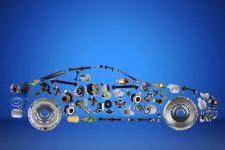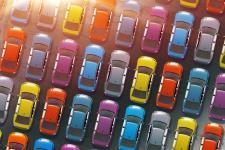Everything you need to know about Driving in Europe

It’s that time of year again when we are praying the British summer will be kind to us! Many of us don’t like to leave our summer sun intake down to chance here in the UK and head abroad to catch a few rays… be warned if you plan to drive there are more differences to remember than which side of the road you need to be on! Here is the Rivervale guide to driving in Europe!
Out of all the European countries only the UK, Irish Republic, Cyprus and Malta drive on the left-hand side. If you are travelling anywhere else in Europe then remember you need to be on the right, this also means traffic on roundabouts will be flowing in an anti-clockwise direction.
Here are some vital checks to do before you drive out of the UK;
- Make sure your breakdown cover extends to Europe
- Ensure your car insurance includes cover for driving abroad
- For all right-hand driving countries in Europe you will need to convert your headlights so you do not dazzle other drivers at night. Converters are as simple as stickers to put on your headlights and are widely available
- If you are driving to anywhere in Europe you will be covering quite a few miles so check your wear and tear items before you leave. This includes; windscreen wipers and tyres. Be sure to fill up on washer fluids and check oil levels and tyre pressures too
- In the excitement of a holiday checking paperwork may slip your mind, but before you go make sure your MOT is valid and will remain valid for the duration of your trip and that your vehicle will also be taxed for your entire holiday
- Do you have a Euro number plate? If you do, the left side of the number plate will display the European Union flag and the letters GB. If you do not have a Euro number plate then you will need to purchase a GB sticker to display so the country of origin can be easily identified
After these checks, there are a few items you will need to have will you when driving in any European Country;
- Full valid driving licence
- Proof of insurance
- Proof of ID (passport)
- Proof of ownership
- Breakdown cover policy
To contact the emergency services in any European country you would call 112.
If you plan on driving abroad after Brexit click here.
The laws then vary depending on the country within the EU you are visiting. The Rivervale guide covers the most popular European destinations; France, Germany, Spain, Belgium, and Italy …
You will be required to abide by the minimum driving ages of the country you are planning to drive in, rather than the laws in your country of origin. Considering this, in France drivers will not be allowed to ride a motorcycle until they are 18 even if they have a UK licence to do so at 17.
You will need to make sure you have some extra items with you in your vehicle when driving in France, you will need to take;
- Enough reflective jackets so the driver and each passenger can wear one in the event of a breakdown or accident (motorcyclists must also have a reflective jacket)
- A warning triangle
- First aid kit
- Breathalyser – if you are stopped by police and suspected of drink driving you are expected to have your own breathalyser with you to use. The breathalyser must be unused, in date and show the French certification mark NF.
If you do not carry these items with you, you may receive an on the spot fine, fines for traffic regulation violations can reach up to €750.
Since March 2017 all drivers in France are not allowed to wear headsets or use headphones of any kind whiles driving, the only exclusion to this are motorcycle helmets which have an integrated system.
There are certain cities in France (Paris, Lyon and Grenoble) where you be required to display a Crit’Air sticker which will indicate how polluting your vehicle is. If air pollution needs to be controlled certain vehicles are not allowed to enter city centres.
Taking Your Car to Paris? Don't Forget Your Crit'Air Sticker!
Think before you use your horn! Warnings between sunlight and sunset should be a flash of the lights. The use of a horn in built up areas must be only in times of immediate danger and you will never be allowed to use a multitone horn, siren or whistle.
Drink Driving
The alcohol limit in France is 49mg of alcohol per 100ml of blood for those who have been driving for over 3 years. For those who have not held their licence for 3 years yet the limit is lower at 19mg of alcohol per 100ml of blood.
Speed Limits
Speed limits in France depend not only on the type of road, but also the type of weather. If you exceed the speed limit by more than 40km/h your driving licence will be confiscated on the spot. French law also means the use of any device which indicates the location of or detects speed cameras is strictly prohibited. This includes any GPS based navigation systems which must have speed camera detection turned off. If you are found to be using a speed camera detection devise you could be fined up to €1,500 or even have your vehicle taken away.
- Motorways, in normal driving conditions the speed limit is 130km/h and rain/precipitation it's 110km/h.
- Urban motorways and dual carriageways with a central reservation, in normal conditions the speed limit is 110km/h and in rain/precipitation this reduces to 100km/h.
- All other roads, in normal conditions the speed limit is 90km/h and in the case of rain/precipitation this changes to 80km/h.
- Built up areas, in normal conditions and in the case of rain/precipitation the speed limit is 50km/h
- When visibility is under 50m the speed limit is 50km/h regardless of the road type.
If you break down in France
Motorways in France are all privately owned so you are not permitted to request your own recovery service. There will be an official breakdown service for your area which can be contacted via orange telephone boxes at regular points along the road. If you are unable to locate one of these phones you should call 112 and ask for assistance.
The cost of recovery could range from €123.90 to €229.82 depending on the size of vehicle and time of recovery. Your breakdown service may be able to pay these costs directly for you or will be able to reimburse you when they receive proof of purchase.
Driving with Children
Children up to the age of 10 or under 1.4m tall must use a suitable child restraint which is determined by weight as follows; under 10kg a rear facing seat, under 13kg a slightly larger rear facing seat, 15-25kg booster seat or cushion with adult seatbelt, 22-36kg slightly larger booster seat or cushion with an adult seatbelt.
Children 10 or under are not allowed to travel in the front seat unless the rear seats are full of younger children.
You must meet the minimum age requirements to drive regardless of the law in your country of origin so in Spain you may not drive a motor vehicle until you are 18 years old.
You must remember to carry the following in your vehicle when driving in Spain;
- Reflective jacket – although this is not compulsory the law states that any person found walking on the road or hard shoulder without one can be fined.
- Warning triangle
- Spare wheel
- If you wear glasses you should carry a spare pair
On the spot fines can be given for any person who is found to be violating a road traffic law. These must be paid immediately by visitors, unless they are able to give the name of a person or corporation who will guarantee payment. If you do not have anyone to guarantee payment or the funds to pay the fine your vehicle may be confiscated until the fine is paid.
You will find lanes marked BUS-VAO in Spain, these are lanes specifically for high occupancy vehicles. You can use these lanes if there are 2 or more people in your car in most places, one exception is the C-58 in Barcelona where you must have 3 people in your vehicle to use the lane.
Drink-Driving in Spain
The blood alcohol limit in Spain is 49 mg of alcohol per 100 ml of blood for those who have been driving for 2 or more years. For those who have been driving for under 2 years the limit is lower at 29 mg of alcohol per 100ml of blood.
Speed Limits
Speed limits in Spain are different depending on the type of road you are travelling on and the type of vehicle you are travelling in. We have included the speed limits for cars and motorhomes below;
Cars
- Motorways - 120km/h
- Dual Carriageways - 100km/h
- all other roads - 90km/h
Motorhomes up to 3,500kg
- Motorways - 100km/h
- Dual Carriageways - 90km/h
- all other roads - 80km/h
Motorhomes over 3,500kg
- Motorways - 90km/h
- Dual Carriageways - 80km/h
- all other roads -80km/h
Driving in Spain with Children
For visitors to Spain any child who is under 12 years old or less than 135 cm tall must be in an appropriate child restraint system.
Children under 12 must not travel in the front seat unless the rear seats are all occupied by younger children or there are no rear seats in the vehicle.
In Germany, you cannot drive until you are 18 even if you have your UK licence at 17.
You must have the following items in your vehicle;
- Reflective jackets
- Warning triangle
- First aid kit
If you violate any traffic laws you can receive an on the spot fine up to €35. If you do not pay this within 1 week legal proceedings will be started. This amount can also be collected as a deposit if it is thought you will receive a higher fine for your infringement. Speeding fines and penalties increase as the amount at which you exceeded the speed limit increases.
Drink Driving
The blood alcohol limit in Germany is 49mg of alcohol per 100ml of blood for drivers with 2 or more years experience. For those drivers who have held their full driving licence for less than 2 years the limit is 0. For these inexperienced drivers, a fine of €250 could be given if even a trace of alcohol is found.
Speed Limits in Germany
Speed limits in Germany differ depending on road type and vehicle type. Below are the most likely vehicles you would be taking on holiday, a car and a camper van.
Cars and vehicles up to 3.5 tonnes
- Motorways and dual carriageways - 130km/h
- All other roads - 100km/h
Camper Vans
- Motorways and dial carriageways - 100km/h
- All other roads - 80km/h
Any type of radar system to alert a driver to the presence of a speed camera are prohibited. If speed cameras are recognised as a function of a navigation system, this feature must be switched off.
Driving with Children
Your children must be secured property or you will risk a €60 fine and 1 point on your driving licence. If your child is 12 years old or younger, or measure less than 1.5m in height they must be in a child restraint. This child seat must conform to ECE r44/03 norm
A child in a rear facing car seat may only travel in the front of the vehicle if the passenger air bag has been deactivated.
You must adhere to the countries minimum age driving laws, this means you cannot drive a motor vehicle in Italy until you are 18.
You must carry these items with you when driving in Italy;
- Reflective jackets
- Warning triangle
Drivers can receive an on the spot fine if they violate any traffic laws. A quarter of this fine must be paid immediately. If you can’t pay your vehicle can be confiscated until you can.
Drink Driving
The limit for alcohol for drivers with 3 or more years’ experience is 50mg of alcohol per 100ml of blood, for professional drivers and those with under 3 year experience no alcohol in the blood is tolerated – the limit is 0.
Speed Limits in Spain
Speed limits in Spain vary according to the type of road you are travelling on.
- Motorways - 130km/h
- Outside built up areas - 90km/h
- Built up areas - 50km/h
If there is rain or any other type of precipitation the speed limit on motorways is reduced to 110km/h
The use of radar detectors to warn drivers of the existence of speed cameras is prohibited, however the points of interest function on a navigation system which will show the location of fixed speed cameras is not yet prohibited.
Driving with Children
For those driving with children in Italy, child restraints must be used in accordance with the laws in their country of origin
You must be 18 years old to drive in Belgium, holding a full UK driving licence at 17 does not entitle you to drive a vehicle.
In your vehicle you must have;
- Reflective jacket
- Warning triangle
- First aid kit
- Fire extinguisher
On roads in Belgium vehicles on rails (trams) will always have priority.
If the road is not wide enough for passing other vehicles in Belgium it is acceptable to use the pavement, providing you do not put any pedestrians at risk!
Between sunrise and sunset, the horn should not be used, instead lights should be flashed as a warning signal.
If you are driving a Motorhome in Belgium you should never be in the left-hand lane on road that have more than 3 lanes for the same direction.
On the spot fines can be issued and must be paid in full or a deposit payment made or your vehicle could be confiscated. Fines for exceeding the speed limit are high.
Drink Driving Limit
The limit for all drivers is 49mg of alcohol per 100ml of blood. However, in Belgium there is a different way of dealing with those who are caught over the limit. If your blood alcohol level is between 50mg and 80mg you will not be allowed to drive for 3 hours so your driving licence will be held and you will receive an on the spot fine of €170. If you are caught with a blood alcohol level of more than 80mg your driving licence will be withdrawn for 6 hours and you will receive a fine of €400. The fine then increases as the amount of alcohol found does. If you are found with more than 150mg of alcohol per 100ml of blood you will always face prosecution with maximum fine of €12,000 and a licence suspension of up to 5 years.
Speed Limits in Belgium
- Motorways - 120km/h
- Other roads - 70km/h
- Residential roads - 20km/h
- Some marked zones - 30km/h
- Road with speed humps - up to 30km/h
If you are driving a motorhome that weighs over 3.5 tonnes you should not exceed 90km/h, even on motorways.
Vehicles on motorways must observe a minimum speed limit of 70km/h – if your vehicle is not capable of reaching this speed then it is not permitted to use the road.
Radars that search for speed cameras are not permitted, but navigation systems that reveal the location of fixed speed cameras are allowed.
Driving with Children
Belgium determine whether a child should be restrained solely on height. If your child measures less than 1.35m tall they should be in an appropriate child seat for their age.





